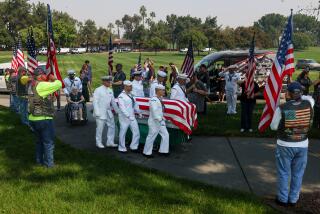When the Messenger Hates the Message : Profile: Ray Blakeney updates families of the dead and missing and tells the media of latest developments.
- Share via
OKLAHOMA CITY — Ray Blakeney had been training for this throughout his career.
But nothing in 30 years of law enforcement, military service and forensic medicine quite prepared him for being the public face of death in the nation’s worst act of terrorism.
For 15 days, as director of operations for the Oklahoma State Medical Examiner’s Office, Blakeney has gone to the First Christian Church each morning and each afternoon, freshly shaven and wearing a clean, starched shirt.
First he has talked to the families of the dead and missing, bringing them the latest news from the search effort at the bombed-out Alfred P. Murrah Federal Building, answering their many questions, reassuring them that everything possible is being done to rescue their loved ones.
Then he has gone to the Jewel Box, a small theater attached to the church. There he has announced the latest body count to the press, handed out updated list of fatalities and answered questions again.
Every day the burden of fatigue and sorrow has grown heavier. Partly it is the enormity of the loss. Partly it is the relentlessness of the grief. Partly it has been the need to walk the impossible line between hope and reality.
*
Family members huddled together at the church have wanted any scrap of information that would sustain their belief that a loved one might be found alive. Reporters have sought to pin Blakeney down on whether he was presuming that all the missing were dead and, in recent days, whether some bodies will be lost forever.
In a voice thick with the accent of his native Arkansas, Blakeney calls reporters “sir” and “ma’am.” Still, he has shown flashes of annoyance at being asked by a late arrival to begin over or to comment on a rumor that some victims might have been alive for several days.
Now, as the search effort nears a sad conclusion with some bodies likely to be permanently trapped inside the rubble, Blakeney said that he wants nothing more than to go home, mow his lawn and tend his neglected flower garden.
Blakeneny, 49, has taught a course for the Federal Emergency Management Agency on “Mass Fatality Incident Response.” The course is a primer for coroners, police and firefighters on what to do when faced with hundreds of violent deaths from a single cause.
At more than one briefing his voice has cracked and his eyes glistened. On Thursday, his eyes welled with tears as he said that the search is nearing an end without all the bodies being retrieved.
“I’ve known all along that we would face this day,” Blakeney said as a hush came over the theater. “This is a very difficult time, but there comes a point when you have to make the tough decision.”
Blakeney moved to Oklahoma to attend Oklahoma Christian College. He served as a Navy medic from 1965 to 1969, including a year attached to a Marine Corps unit in Vietnam. He was with the Police Department in Midwest City, a suburb of Oklahoma City, from 1969 to 1979. Asked to describe himself, Blakeney said simply: “A Southern boy, a Baptist.”
He went to the medical examiner’s office in 1980 as an investigator and was promoted in 1987 to director of operations, the highest position held by a non-physician. At the height of the rescue and identification effort, Blakeney oversaw the work of 400 full-time employees and volunteers.
Dr. Fred B. Jordan, Oklahoma City’s medical examiner, has been busy overseeing autopsies and has made no public comments or met with families--so Blakeney has done both jobs.
In his career, he has worked on two of the nation’s more notorious cases of mass death: the 15 people killed by a disgruntled postal worker in Edmond, and the 24 killed in an explosion at a fireworks factory in eastern Oklahoma.
The federal building bombing tragedy, however, was unlike the earlier episodes in many respects, Blakeney said. First, the bombing involved the death of children, and it contained the horror of large numbers of missing, which at one time totaled more than 150.
“This case has gone on so long,” Blakeney said. “It’s impossible to prepare for a thing like that.”
His role as liaison officer to families of the missing and spokesman to the press put him in the touchy position of having to smooth over a furor that erupted on Monday morning, after Gov. Frank Keating the night before had overstated the significance of shifting the search effort from hand-held tools to heavy equipment.
Keating’s comments, carried live on local television, caused family members to think that the search was being abandoned altogether.
Blakeney explained that this was not the case, but he declined to lay blame on either the governor or the media, diplomatically using the passive tense to explain that “bad information has gotten out.”
Badgered by reporters to explain what has sustained him during the emotional and exhausting weeks, Blakeney has consistently given the same answer.
“The families,” he said. “They’re what keeps me going.”
More to Read
Sign up for Essential California
The most important California stories and recommendations in your inbox every morning.
You may occasionally receive promotional content from the Los Angeles Times.












